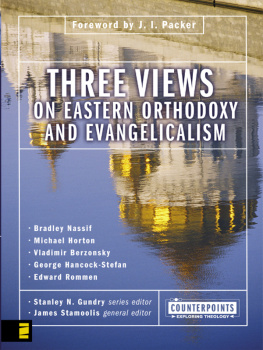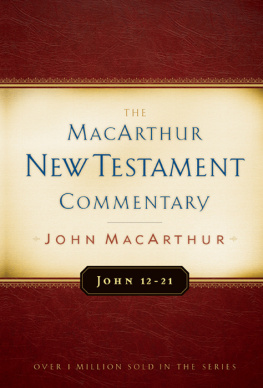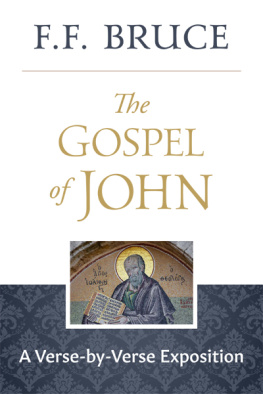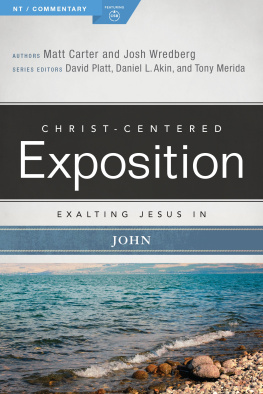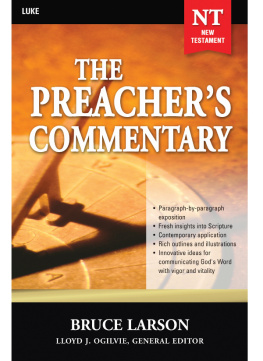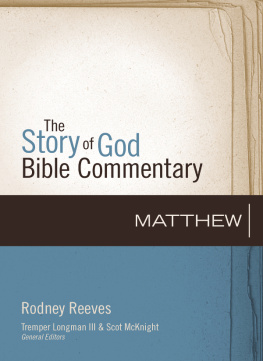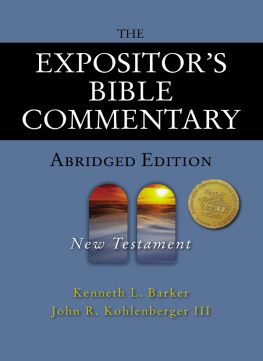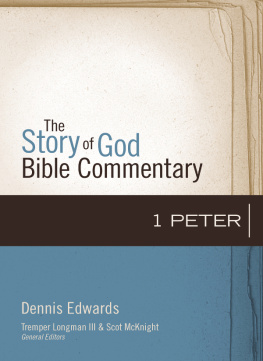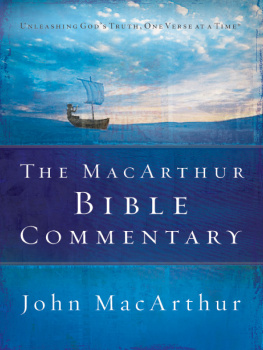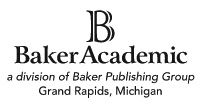Robert H. Gundry
2010 by Robert H. Gundry
P.O. Box 6287, Grand Rapids, MI 49516-6287
Previously appeared in Robert H. Gundry, Commentary on the New Testament (Baker Academic, 2010).
All rights reserved. No part of this publication may be reproduced, stored in a retrieval system, or transmitted in any form or by any meansfor example, electronic, photocopy, recordingwithout the prior written permission of the publisher. The only exception is brief quotations in printed reviews.
Library of Congress Cataloging-in-Publication Data for Commentary on the New Testament is on file at the Library of Congress, Washington, DC.
Contents
A PROLOGUE ON JESUS AS THE WORD
John 1:118
MAKING THE FIRST DISCIPLES
John 1:1951
THE SIGN OF WATER TO WINE
John 2:111
THE CLEANSING OF THE TEMPLE
John 2:1222
BELIEVING AND UNBELIEVING IN JERUSALEM
John 2:233:21
THE BAPTISTS FURTHER TESTIMONY TO JESUS
John 3:2236
JESUS AND THE SAMARITAN WOMAN
John 4:142
JESUS HEALING THE SON OF A ROYAL OFFICIAL BY MERELY SPEAKING AT A DISTANCE
John 4:4354
THE HEALING OF A PARALYZED MAN
John 5:13a, 59a
A DISPUTE OVER THE SABBATH BETWEEN THE JEWS AND JESUS
John 5:9b47
JESUS FEEDING THE FIVE THOUSAND
John 6:115
JESUS WALKING ON WATER
John 6:1621
ON THE SACRIFICIAL FLESH AND BLOOD OF JESUS
John 6:2258
APOSTASY VERSUS PERSEVERANCE
John 6:5971
HOW TO GO TO THE FESTIVAL OF TABERNACLES
John 7:113
TEACHING AND DIALOGUE IN THE TEMPLE COURTS AT THE FESTIVAL OF TABERNACLES
John 7:1452
DIALOGUE IN JERUSALEM AFTER THE FESTIVAL OF TABERNACLES
John 8:1259
THE SIGN OF JESUS GIVING SIGHT TO A MAN BORN BLIND
John 9:141
JESUS AS THE GATE AND AS THE GOOD SHEPHERD
John 10:121
A DISPUTE OVER JESUS DEITY
John 10:2239
THE RAISING OF LAZARUS
John 10:4011:45
THE SANHEDRINS DECISION TO KILL JESUS
John 11:4654
THE ANOINTING OF JESUS
John 11:5512:8
THE SANHEDRINS PLAN TO KILL LAZARUS
John 12:911
THE TRIUMPHAL PROCESSION OF JESUS
John 12:1219
JESUS RESPONSE TO SOME GREEKS WANTING TO SEE HIM
John 12:2026
JESUS DETERMINATION TO GO THROUGH HIS HOUR
John 12:2736a
JOHNS COMMENTARY
John 12:36b43
JESUS COMMENTARY
John 12:4450
JESUS WASHING THE DISCIPLES FEET AT THE LAST SUPPER
John 13:120
THE EXIT OF JUDAS ISCARIOT
John 13:2130
JESUS DISCOURSE AT THE LAST SUPPER
John 13:3116:33
JESUS PRAYER
John 17:126
JESUS GETTING HIMSELF ARRESTED
John 18:111
JESUS WITHSTANDING INTERROGATION BY CAIAPHAS IN CONTRAST WITH PETERS DENIALS OF JESUS
John 18:1227
JESUS WITHSTANDING INTERROGATION BY PILATE IN CONTRAST WITH PILATES YIELDING TO THE JEWISH AUTHORITIES
John 18:2819:16a
JESUS FINISHING HIS SIGNS, WORKS, AND WORDS AND THE START OF HIS GLORIFICATION
John 19:16b30
THE GLORIFICATION OF JESUS IN HIS BURIAL
John 19:3142
THE SELF-RAISING OF JESUS FROM HIS TOMB TO GOD THE FATHER IN HEAVEN
John 20:118
THE FIRST COMING OF JESUS TO HIS DISCIPLES
John 20:1925
THE SECOND COMING OF JESUS TO HIS DISCIPLES
John 20:2629
THE PURPOSE OF JOHNS GOSPEL
John 20:3031
THE THIRD COMING OF JESUS TO HIS DISCIPLES
John 21:123
THE RELIABILITY AND SELECTIVITY OF JOHNS GOSPEL
John 21:2425
Acknowledgments
My sincere thanks to Shirley Decker-Lucke, Editorial Director at Hendrickson Publishers, for accepting this exposition of the New Testament for publication; to Mark House, Phil Frank, and others for their work there on the publication; and to the Baker Academic team for their work on this reprint. My brother Stan Gundry, whose contributions to Christian publishing are deservedly well-known, encouraged me to write the exposition. Connie Gundry Tappy copyedited the manuscript. Her copyediting included not only the correction of errors and the refinement of style, but also a host of interpretive improvements and scriptural cross-references arising out of her comprehensive knowledge of the Bible. To her, my daughter as well as my copyeditor, I affectionately dedicate this volume.
Robert H. Gundry
Westmont College
Santa Barbara, California
Introduction
Dear reader,
Here you have part of a commentary on the whole New Testament, published by Baker Academic both in hardback and as an ebook. The electronic version has been broken into segments for your convenience and affordability, though if you like what you find here you may want to consider the whole at a proportionately lower cost. Whether in whole or in part, the e-version puts my comments at your fingertips on your easily portable Kindle, iPad, smartphone, or similar device.
Ive written this commentary especially for busy people like youlay people with jobs and families that take up a lot of time, Bible study leaders, pastors, and all who take the New Testament seriouslythat is, people who time-wise and perhaps money-wise cant afford the luxury of numerous heavyweight, technical commentaries on the individual books making up the section of the Bible we call the New Testament. So technical questions are avoided almost entirely, and the commentary concentrates on what will prove useful for understanding the scriptural text as a basis for your personal life as a Christian, for discussion with others, and for teaching and preaching.
Group discussion, teaching, and preaching all involve speaking aloud, of course, and when the New Testament was written, even private reading was done aloud. Moreover, most authors dictated their material to a writing secretary, and books were ordinarily read aloud to an audience. In this commentary, then, Ive avoided almost all abbreviations (which dont come through as such in oral speech) and have freely used contractions that characterize speaking (well, youre, theyve, and so on). To indicate emphasis in oral speech, italics also occur fairly often.
Youll mostly have to make your own practical and devotional applications of the scriptural text. But such applications shouldnt disregard or violate the meanings intended by the Scriptures divinely inspired authors and should draw on the richness of those meanings. So Ive interpreted them in detail. Bold print indicates the text being interpreted. Translations of the original Greek are my own. Because of the interpretations close attention to detail, my translations usually, though not always, gravitate to the literal and sometimes produce run-on sentences and other nonstandard, convoluted, and even highly unnatural English. Square brackets enclose intervening clarifications, however, plus words in English that dont correspond to words in the Greek text but do need supplying to make good sense. (As a language, Greek has a much greater tendency than English does to omit words meant to be supplied mentally.) Seemingly odd word-choices in a translation get justified in the following comments. It needs to be said as well that the very awkwardness of a literal translation often highlights features of the scriptural text obscured, eclipsed, or even contradicted by loose translations and paraphrases.
Literal translation also produces some politically incorrect English. Though brothers often includes sisters, for example, sisters doesnt include brothers. Similarly, masculine pronouns may include females as well as males, but not vice versa. These pronouns, brothers, and other masculine expressions that on occasion are gender-inclusive correspond to the original, however, and help give a linguistic feel for the male-dominated culture in which the New Testament originated and which its language reflects. Preachers, Bible study leaders, and others should make whatever adjustments they think necessary for contemporary audiences but should not garble the texts intended meaning.


